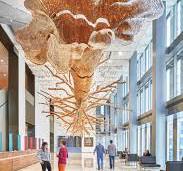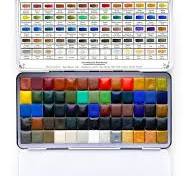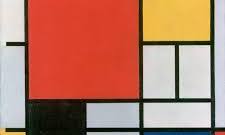The Transformative Power of Art Installations
Art installations have the remarkable ability to transcend traditional boundaries of art and immerse viewers in a multisensory experience. These dynamic and interactive installations challenge conventional notions of art by incorporating elements of space, light, sound, and audience participation.
Engaging the Senses
One of the most captivating aspects of art installations is their capacity to engage all the senses. By combining visual elements with auditory and tactile components, installations create a holistic experience that stimulates emotions and sparks contemplation. Viewers are not mere spectators but active participants in the artwork, invited to explore, interact, and interpret in their unique way.
Exploring Space and Environment
Art installations often redefine physical spaces, transforming galleries, public areas, or outdoor landscapes into immersive environments. Artists play with scale, perspective, and materials to create installations that challenge perceptions of space and invite viewers to reconsider their relationship with the surroundings. These interventions blur the line between art and architecture, inviting dialogue on how we inhabit and interact with our environment.
Social Commentary and Cultural Reflection
Many art installations serve as a platform for social commentary and cultural reflection. Artists use this medium to address pressing issues, provoke thought, or celebrate diversity. Through symbolism, metaphor, or direct representation, installations can convey powerful messages that resonate with viewers on a personal or collective level. They become a catalyst for conversation and introspection on topics ranging from politics to identity to environmental concerns.
The Evolving Landscape of Art Installations
As technology advances and artistic boundaries expand, the possibilities for art installations continue to grow. Artists experiment with new mediums such as virtual reality, augmented reality, interactive digital displays, and kinetic sculptures to push the limits of creativity and engagement. The intersection of art and technology opens up exciting avenues for innovation in creating immersive experiences that captivate audiences in unexpected ways.
In conclusion, art installations offer a dynamic canvas for artists to express themselves creatively while inviting viewers into a world where imagination knows no bounds. Through sensory exploration, spatial manipulation,
and cultural discourse,
these transformative artworks enrich our lives by challenging us to see the world through a different lens.
Exploring the Impact: Nine Ways Art Installations Enrich and Transform Artistic Experience
- Engages multiple senses for a rich and immersive experience.
- Transforms physical spaces into dynamic and interactive environments.
- Encourages audience participation, making viewers active participants.
- Provides a platform for social commentary and cultural reflection.
- Challenges traditional notions of art and expands creative boundaries.
- Creates opportunities for artists to experiment with new mediums and technologies.
- Promotes dialogue and introspection on diverse topics through symbolism and metaphor.
- Captivates audiences with innovative approaches to storytelling and expression.
- Offers a unique way to explore complex ideas and emotions through visual language.
Challenges and Considerations in Art Installations: Accessibility, Costs, and Environmental Impact
- 1. Accessibility challenges for individuals with disabilities
- 2. High cost of production and maintenance
- 3. Limited lifespan due to temporary nature of some installations
- 4. Potential for misinterpretation or lack of understanding by viewers
- 5. Space constraints in exhibiting large-scale installations
- 6. Environmental impact from materials used in installations
- 7. Risk of damage or vandalism in public art installations
Engages multiple senses for a rich and immersive experience.
Art installations have the remarkable ability to engage multiple senses, offering viewers a rich and immersive experience that goes beyond traditional forms of art. By incorporating elements of sight, sound, touch, and sometimes even smell, these installations create a multisensory environment that stimulates emotions and deepens the connection between the artwork and the audience. This sensory engagement not only enhances the aesthetic appeal of the installation but also allows viewers to fully immerse themselves in the artist’s creative vision, resulting in a truly unforgettable and transformative encounter with art.
Transforms physical spaces into dynamic and interactive environments.
Art installations have the remarkable ability to transform physical spaces into dynamic and interactive environments that captivate and engage viewers. By redefining traditional gallery settings or public areas, these installations breathe new life into otherwise static spaces, inviting audiences to immerse themselves in a world where art transcends boundaries. Through the clever manipulation of space, light, sound, and materials, artists create immersive experiences that encourage exploration, interaction, and contemplation. This pro of art installations not only enhances the aesthetic appeal of a space but also fosters a sense of connection between the artwork and its surroundings, turning passive observers into active participants in a truly transformative experience.
Encourages audience participation, making viewers active participants.
Art installations have the unique pro of encouraging audience participation, transforming viewers from passive observers into active participants in the artistic experience. By inviting engagement and interaction, these installations create a dynamic relationship between the artwork and the audience. Viewers are encouraged to explore, touch, move around, and even contribute to the narrative of the installation, fostering a deeper connection with the art and allowing for personal interpretation and reflection. This immersive approach not only enhances the viewing experience but also empowers individuals to become co-creators of meaning within the artistic space.
Provides a platform for social commentary and cultural reflection.
Art installations serve as a powerful platform for social commentary and cultural reflection, allowing artists to address pressing issues, provoke thought, and celebrate diversity. Through symbolism, metaphor, or direct representation, these installations convey profound messages that resonate with viewers on personal and collective levels. By sparking dialogue and introspection on topics such as politics, identity, and environmental concerns, art installations play a vital role in raising awareness and fostering understanding within society.
Challenges traditional notions of art and expands creative boundaries.
Art installations have the remarkable ability to challenge traditional notions of art and expand creative boundaries in ways that push the limits of artistic expression. By breaking free from the constraints of conventional art forms, installations open up a world of possibilities where artists can experiment with new materials, techniques, and concepts. This pro of art installations encourages artists to think outside the box, fostering innovation and originality in their work. Through this exploration of uncharted territory, art installations inspire both creators and viewers to embrace a more expansive and inclusive definition of art that celebrates diversity, creativity, and imagination.
Creates opportunities for artists to experiment with new mediums and technologies.
Art installations create exciting opportunities for artists to explore and experiment with new mediums and technologies, pushing the boundaries of creativity and innovation. By integrating elements such as virtual reality, interactive digital displays, kinetic sculptures, and more, artists can unleash their imagination and bring their visions to life in ways that were previously unimaginable. This pro of art installations not only challenges artists to think outside the box but also allows them to engage with audiences in fresh and captivating ways, fostering a dynamic relationship between art, technology, and human experience.
Promotes dialogue and introspection on diverse topics through symbolism and metaphor.
Art installations serve as a powerful medium that promotes dialogue and introspection on diverse topics through symbolism and metaphor. By using visual elements to convey deeper meanings, artists can spark conversations and reflections on complex issues such as social justice, environmental sustainability, cultural identity, and human emotions. Viewers are encouraged to interpret the symbolism and metaphors in their own unique ways, leading to a deeper understanding of the subject matter and fostering empathy and connection among individuals with varying perspectives. This pro of art installations highlights their capacity to transcend language barriers and evoke emotional responses that resonate on a universal level.
Captivates audiences with innovative approaches to storytelling and expression.
Art installations captivate audiences with innovative approaches to storytelling and expression, transcending traditional artistic forms. By merging visual, auditory, and interactive elements, these installations create immersive narratives that engage viewers on multiple levels. Through unique spatial arrangements, sensory experiences, and thought-provoking themes, artists push the boundaries of creativity and invite audiences to participate in a dynamic dialogue with the artwork. This captivating fusion of storytelling and expression in art installations not only stimulates the imagination but also fosters a deeper connection between the artwork and its audience, leaving a lasting impact on those who experience it.
Offers a unique way to explore complex ideas and emotions through visual language.
Art installations provide a distinctive avenue for delving into intricate concepts and emotions through the language of visuals. By combining various artistic elements in a spatial context, artists can convey nuanced ideas and evoke deep emotions in viewers. The immersive nature of art installations allows for a more profound exploration of complex themes, enabling audiences to engage with the artwork on a visceral level. Through this visual language, artists can communicate abstract concepts, provoke introspection, and create meaningful connections that transcend traditional artistic expressions.
1. Accessibility challenges for individuals with disabilities
Art installations, while offering immersive and engaging experiences for many, can present significant accessibility challenges for individuals with disabilities. The interactive nature and spatial design of installations may not always consider the needs of those with mobility, visual, or auditory impairments. Lack of appropriate accommodations such as wheelchair ramps, tactile elements for the visually impaired, or sign language interpretation can exclude individuals from fully participating in and appreciating the artwork. Addressing these accessibility limitations is crucial to ensure that art installations remain inclusive and accessible to all members of the community, fostering a more diverse and enriching cultural experience for everyone.
2. High cost of production and maintenance
The high cost of production and maintenance is a significant challenge faced by art installations. Creating large-scale, intricate installations often requires substantial financial resources for materials, equipment, and labor. Additionally, maintaining the integrity and functionality of these installations over time can be costly, especially for works that are exposed to environmental elements or require specialized care. The financial investment needed for the production and upkeep of art installations can limit the accessibility of this art form to a wider audience and may pose sustainability challenges for artists and institutions in the long run.
3. Limited lifespan due to temporary nature of some installations
The limited lifespan of art installations due to the temporary nature of some artworks poses a significant challenge for both artists and audiences. While the impermanence of these installations can add a sense of urgency and ephemerality to the viewing experience, it also means that once the installation is dismantled or removed, its impact may be lost forever. This transience raises questions about the preservation and documentation of temporary art, as well as the accessibility of these works to a wider audience who may miss the opportunity to engage with them in person. The fleeting nature of such installations highlights the fragility of art in a world where permanence is often valued, underscoring the need for innovative approaches to ensure that these ephemeral creations leave a lasting legacy in the realm of contemporary art.
4. Potential for misinterpretation or lack of understanding by viewers
Art installations, while powerful in their ability to provoke thought and emotion, also carry the risk of being misinterpreted or misunderstood by viewers. The complexity and abstract nature of some installations may lead to varying interpretations, causing confusion or a lack of understanding among audience members. Different backgrounds, perspectives, and levels of art appreciation can further contribute to this conundrum, potentially diluting the intended message or impact of the artwork. Artists must navigate this challenge by considering clarity in communication and providing context to help guide viewers towards a deeper appreciation and comprehension of their installations.
5. Space constraints in exhibiting large-scale installations
Space constraints in exhibiting large-scale installations present a significant challenge for artists and curators alike. The sheer size and dimensions of some installations require ample space to be fully appreciated and experienced by viewers. Limited exhibition venues may not have the capacity to accommodate these large-scale works, restricting the artist’s ability to showcase their vision in its intended form. Additionally, logistical issues such as transportation and installation logistics can further complicate the process of bringing these monumental artworks to fruition. Despite these challenges, innovative solutions and alternative presentation formats can sometimes overcome space constraints, allowing artists to adapt their installations to different environments while still preserving the essence of their artistic expression.
6. Environmental impact from materials used in installations
Art installations, while captivating and thought-provoking, can pose a significant con in terms of their environmental impact resulting from the materials used in creating these artworks. The production of art installations often involves a variety of materials that may not be environmentally friendly or sustainable. From plastics to chemicals to non-biodegradable substances, the use of such materials can contribute to pollution, waste generation, and resource depletion. Artists and creators are increasingly being called upon to consider the ecological footprint of their installations and explore more eco-conscious approaches to minimize the negative environmental consequences associated with their artistic endeavors.
7. Risk of damage or vandalism in public art installations
Public art installations face the significant con of being at risk of damage or vandalism. Due to their accessibility and visibility in public spaces, these installations are vulnerable to intentional or unintentional harm caused by individuals or external factors. Acts of vandalism can not only deface the artwork but also diminish its intended impact on the community. Artists and organizers must consider security measures and maintenance strategies to protect public art installations from potential damage and ensure their longevity for all to enjoy.





